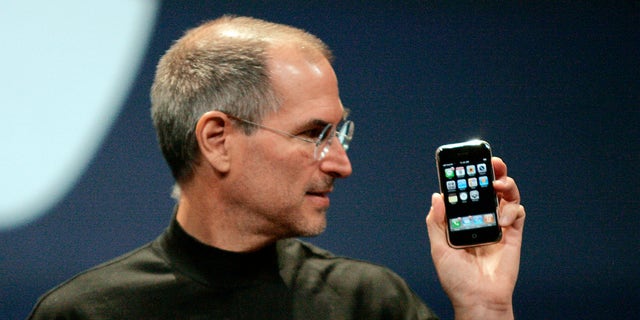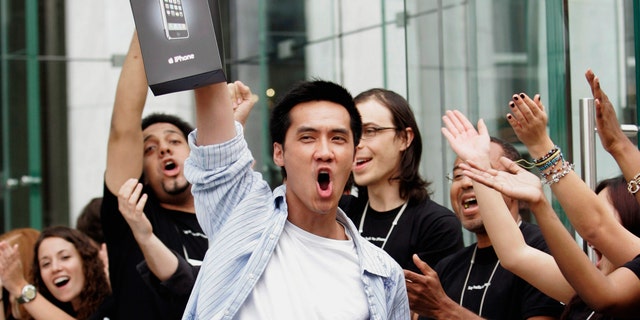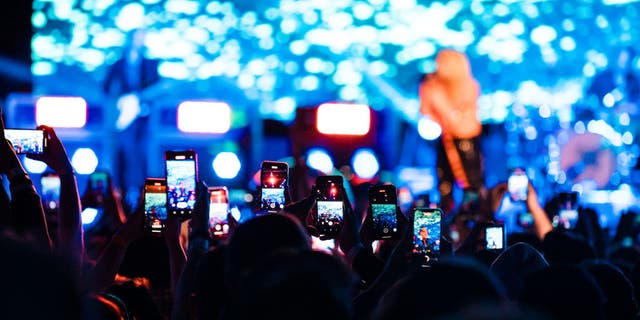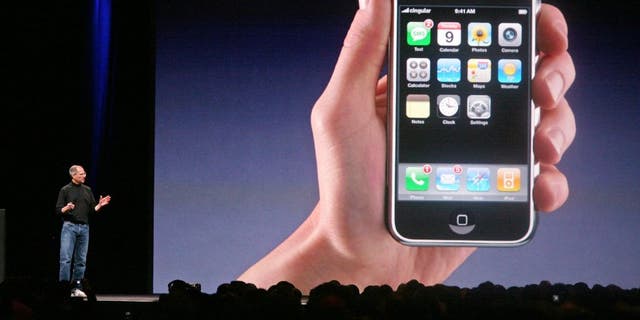Apple CEO Steve Jobs gave the world its first look at the iPhone — as well as a glimpse into a radically different future of personal computing and communications — on this day in history, Jan. 9, 2007.
“It’s not just the bestselling gadget ever created: It’s probably the most influential one, too,” Wired wrote in a 2018 retrospective of the first decade of the iPhone.
“Its influence goes far beyond other phones — the infrastructure that made the iPhone also enabled drones, smart-home gadgets, wearables and self-driving cars.”
ON THIS DAY IN HISTORY, JAN. 8, 1790, GEORGE WASHINGTON DELIVERS FIRST-EVER STATE OF THE UNION ADDRESS
The iPhone offered a fingertip touch screen, a powerful camera and easy access to the internet, among many other features, providing huge advances over existing smartphones such as the Blackberry, Moto Q and Palm Treo.
“Every once in a while, a revolutionary product comes along that changes everything,” Jobs, dressed in his signature black mock turtleneck, boasted at the Macworld Expo in San Francisco.

Then-Apple CEO Steve Jobs holds the iPhone in San Francisco, California, on Jan. 9, 2007.
(REUTERS/Kimberly White)
The Apple co-founder noted that the Macintosh in 1984 “changed the whole computer industry” and that the iPod (introduced on the same Jan. 9 date as the iPhone, but in 2001) “changed the entire music industry.”
He added, “Today, we’re introducing three revolutionary products.”
“Every once in a while, a revolutionary product comes along that changes everything.” — Steve Jobs
The new Apple offerings included “a widescreen iPod with touch controls” and a “breakthrough communications device.”
The Macworld audience erupted, however, when he mentioned that among the three new products was “a revolutionary mobile phone.”
Apple had yet to enter the burgeoning smartphone market at that point. So tech enthusiasts eagerly awaited the pioneering computer giant’s long-rumored dramatic entry into the segment.
MEET THE AMERICAN WHO INVENTED THE TV REMOTE CONTROL: SELF-TAUGHT CHICAGO ENGINEER EUGENE POLLEY
Jobs, who died in October 2011 after a long battle with cancer, delivered on the drama.
“These are not three separate devices,” he warned. “These are one device. And we’re calling it the iPhone.”
“The first generation iPhone was, in many days, quite different than the ones we see in use today. For one thing, it was small, just 4.5 inches by 2.4 inches. By comparison, the iPhone XS Max launched in 2018 is 6.2 inches by 3.05 inches,” Steven Silver wrote for Apple Insider in 2018.
The latest model, the iPhone 14, comes with a 6.7-inch version.

Surrounded by cheering Apple Store employees, one of the first iPhone buyers leaves the store on Fifth Avenue in Manhattan on June 29, 2007.
(REUTERS/Jeff Zelevansky)
Silver added that the first iPhone “also had no third-party apps whatsoever, and it topped out at 16GB of flash memory. The first iPhone was exclusive to AT&T, and ran only on AT&T’s notoriously slow and unreliable EDGE GSM network.”
Still, the author and other experts noted, “That first iPhone was hugely important.”
It was also hugely popular.
“Sales of iPhones accounted for 52% of Apple’s $365 billion in sales in 2021.”
Apple sold 6.1 million first-generation iPhones between the time it released the product to the public on June 29, 2007, and discontinued it on July 15, 2008.
Greg Packer, then 59, a former highway maintenance worker from Long Island, is credited with being the first person to purchase an iPhone on June 29 at the Apple Store on Fifth Avenue in Manhattan after he reportedly camped out all week.

A general view of the audience during Avril Lavigne concert with smartphones at Espaco Unimed on Sept. 7, 2022, in Sao Paulo, Brazil.
(Mauricio Santana/Getty Images)
About 2 billion iPhones have been sold since its introduction, with nearly 800 million in use around the world today – about one for every 10 people on the planet, according to estimates by various tech analysts.
LOCAL STORE SIGN ABOUT ‘TRIGGERS’ IGNITES DEBATE ON REDDIT: ‘NOBODY’S RESPONSIBILITY BUT YOUR OWN’
The iPhone, and the advances in technology it forced on other smartphones, has had a profound impact on the way people live.
“Millions of people use an iPhone as their only computer,” Wired notes. “And their only camera, GPS device, music player, communicator, trip planner, sex finder and payment tool. It put the world in our pockets.”
“Has it become a poor substitute for ‘real’ relationships?”
It also spawned an entire new industry of app developers, accessory makers and social-media giants.
The iPhone also had an immediate and profound impact on Apple’s bottom line.
CLICK HERE TO SIGN UP FOR OUR LIFESTYLE NEWSLETTER
“Just under 40% of Apple’s revenue can now be attributed to the iPhone,” CNET reported in October 2008.
Sales of iPhones accounted for 52% of Apple’s $365 billion in sales in 2021, according to company reports.

Apple CEO Steve Jobs introduces the new iPhone at Macworld in San Francisco on Tuesday, Jan. 9, 2007.
(John Green, MediaNews Group/Bay Area News via Getty Images)
The iPhone’s impact on our lives has been profound.
The way humans attend concerts and sporting events, follow directions and chronicle their daily lives all changed with the presence of the iPhone.
But whether the iPhone is a net positive on society remains to be seen, argue some experts.
“In 2007, when the iPhone debuted, people eagerly welcomed it, says sociologist Judy Wajcman,” author Heidi Hackford wrote for the Computer History Museum in 2018.
CLICK HERE TO GET THE FOX NEWS APP
“It was viewed, like mobile phones before it, as another helpful way to synchronize with family, friends and community. But, has that line between work time and personal time eroded even more because of the device? And has it become a poor substitute for ‘real’ relationships?”
The author also noted, “As with any new technology, the reviews are mixed.”